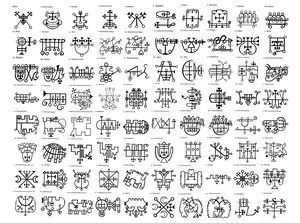Sigil
A sigil (/ˈsɪdʒɪl/)[1] is a type of symbol used in magic. The term has usually referred to a pictorial signature of a deity or spirit. In modern usage, especially in the context of chaos magic, sigil refers to a symbolic representation of the practitioner's desired outcome.

| Part of a series on |
| Magic |
|---|
 |
History

The use of symbols for magical or cultic purposes has been widespread since at least the Neolithic era. The term sigil derives from the Latin sigillum (pl. sigilla or sigils), meaning "seal."[2]
In medieval magic, the term sigil was commonly used to refer to occult signs which represented various angels and demons which the practitioner might summon.[2] The magical training books called grimoires often listed pages of such sigils. A particularly well-known list is in The Lesser Key of Solomon, in which the sigils of the 72 princes of the hierarchy of hell are given for the magician's use. Such sigils are considered by some to be the equivalent of the true name of the spirit and thus granted the magician a measure of control over the beings.[3]

A common method of creating the sigils of certain spirits was to use kameas, a special use case of magic squares — the names of the spirits were converted to numbers, which were then located on the magic square. The locations were then connected by lines, forming an abstract figure.[4]
The word sigil [...] has a long history in Western magic. The members of the Golden Dawn were perfectly familiar with it ("combining the letters, the colours, the attributions and their Synthesis, thou mayest build up a telesmatic Image of a Force. The Sigil shall then serve thee for the tracing of a Current which shall call into action a certain Elemental Force") and it was used in the making of talismans. The sigil was like a signature or sign of an occult entity.[5]
Austin Osman Spare
Artist and occultist Austin Osman Spare (1886–1956) developed his own unique method of creating and using sigils, which has had a huge effect on modern occultism. Spare did not agree with medieval practice of using these, arguing that such supernatural beings were simply complexes in the unconscious, and could be actively created through the process of sigilization.[6][5]
Spare's technique became a cornerstone of chaos magic (see next section).[7] It also influenced artist Brion Gysin, who experimented with combining Spare's sigil method with the traditional form of magic squares:
Calligraphic magick squares were one of the techniques most commonly applied by Gysin. He would reduce a name or an idea to a "glyph" and then write across the paper from right to left, turn the paper and do the same again, and so on, turning the paper around and around to create a multidimensional grid... The same techniques and consciously driven functional intention also permeated his paintings. In a very real sense, everything he created was an act of sorcery.[8]
Chaos magic

In chaos magic, following Spare, sigils are commonly created in a well ordered fashion by writing an intention, then condensing the letters of the statement down to form a sort of monogram. The chaos magician then uses the gnostic state to "launch" or "charge" the sigil – essentially bypassing the conscious mind to implant the desire in the unconscious.[9][7] To quote Ray Sherwin:
The magician acknowledges a desire, he lists the appropriate symbols and arranges them into an easily visualised glyph. Using any of the gnostic techniques he reifies the sigil and then, by force of will, hurls it into his subconscious from where the sigil can begin to work unencumbered by desire.[9]
After charging the sigil, it is considered necessary to repress all memory of it. In the words of Spare, there should be "a deliberate striving to forget it".[6]
In modern chaos magic, when a complex of thoughts, desires, and intentions gains such a level of sophistication that it appears to operate autonomously from the magician's consciousness, as if it were an independent being, then such a complex is referred to as a servitor.[10] When such a being becomes large enough that it exists independently of any one individual, as a form of "group mind", then it is referred to as an egregore.[11][12]
Later chaos magicians have expanded on the basic sigilization technique. Grant Morrison coined the term hypersigil to refer to an extended work of art with magical meaning and willpower, created using adapted processes of sigilization. Their comic book series The Invisibles was intended as such a hypersigil.[7] Morrison has also argued that modern corporate logos like "the McDonald's Golden Arches, the Nike swoosh and the Virgin autograph" are a form of viral sigil:
Corporate sigils are super-breeders. They attack unbranded imaginative space. They invade Red Square, they infest the cranky streets of Tibet, they etch themselves into hairstyles. They breed across clothing, turning people into advertising hoardings... The logo or brand, like any sigil, is a condensation, a compressed, symbolic summoning up of the world of desire which the corporation intends to represent... Walt Disney died long ago but his sigil, that familiar, cartoonish signature, persists, carrying its own vast weight of meanings, associations, nostalgia and significance.[7]
See also
- Apotropaic magic – Magic intended to repel evil
- Behenian fixed star – Fifteen stars with magical significance in medieval astrology
- Ceremonial magic – System of magical rituals drawing from many historical and modern sources
- Icelandic magical staves – Sigils found in ancient Icelandic grimoires
- List of sigils of demons
- Runic magic – Magic using runes or runestones
- Seal of Solomon – Purported magical signet ring of the biblical King Solomon
- Sigil of Baphomet – The official insignia of the Church of Satan
- Sigillum Dei – "Seal of God", dating to at least the Middle Ages; purported to give a skilled user the ability to control all living creatures except archangels
- Sympathetic magic – Set of magical beliefs and practices centered around the principles that like effects like and connections between objects remain, regardless of time or distance
- Veve – A magic and religious symbol in Voodoo representing a lwa
References
Citations
- "sigil". The Chambers Dictionary (9th ed.). Chambers. 2003. ISBN 0-550-10105-5.
- Weschcke & Slate (2011), p. .
- Peterson (2001), pp. xi–xviii.
- Greer (2003), p. 438.
- Baker (2011), p. .
- Spare (2005), p. .
- Morrison (2003), p. .
- P-Orridge (2003), p. .
- Sherwin (1992), p. .
- Hine (1998), p. .
- Rysen (1999).
- Emerson (1997).
Works cited
- Baker, Phil (2011). Austin Osman Spare: The Life and Legend of London's Lost Artist. Strange Attractor. ISBN 9781907222016.
- Emerson, Gabriel (1997). "Egregore Definition Compilation". Chaos Matrix. Retrieved June 7, 2018.
- Greer, John Michael (2003). The New Encyclopedia of The Occult. Llewellyn Worldwide. ISBN 1-56718-336-0.
- Hine, Phil (1998). Prime Chaos: Adventures in Chaos Magic. New Falcon Publications. ISBN 9781609255299.
- Morrison, Grant (2003). "Pop Magic!". In Metzger, Richard (ed.). Book of Lies: The Disinformation Guide to Magick and the Occult. Red Wheel Weiser. ISBN 9780971394278.
- P-Orridge, Genesis (2003). "Magick Squares and Future Beats". In Metzger, Richard (ed.). Book of Lies: The Disinformation Guide to Magick and the Occult. Red Wheel Weiser. ISBN 9780971394278.
- Peterson, Joseph H., ed. (2001). The Lesser Key of Solomon: Lemegeton Clavicula Salomonis. York Beach, ME: Weiser Books.
- Rysen, Fenwick (1999). "The Fluid Continuum --or-- What the f***'s an Egregore?". Chaos Matrix. Retrieved June 7, 2018.
- Sherwin, Ray (1992). The Book of Results. Revelations 23 Press. ISBN 9781874171003.
- Spare, Austin Osman (2005). The Book of Pleasure: The Psychology of Ecstasy (Facsimile ed.). I-H-O Books. ISBN 1-872189-58-X.
- Weschcke, Carl Llewellyn; Slate, Joe H. (2011). The Llewellyn Complete Book of Psychic Empowerment: A Compendium of Tools & Techniques for Growth & Transformation. Llewellyn Worldwide. ISBN 9780738729862.
Further reading
- Carroll, Peter (1987). Liber Null and Psychonaut. Weiser Books. ISBN 0-87728-639-6.
- El, Moorpheus (2011). "Secret of Secrets: Reality is Programmable". Matrix-Five. Retrieved August 28, 2011.
- Marik (1998). "Servitors: Part Two of Sigils, Servitors, and Godforms". Chaos Matrix. Retrieved June 7, 2018.
- Meek, Kyle (2010). What Is A Sigil?: The Complete Guide to the Theory and Practice of Creating Magickal Symbols. KDIB Studios. ASIN B08BX4HG9Q.